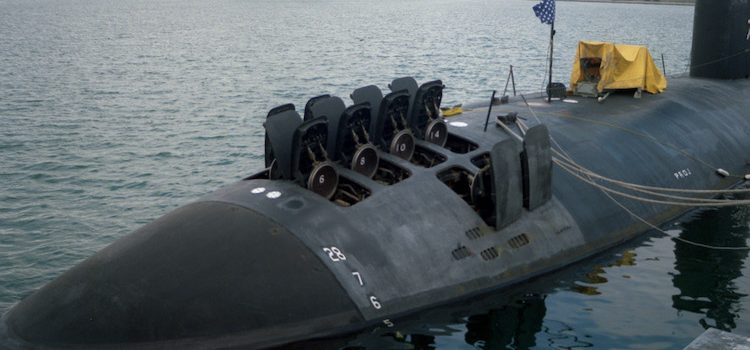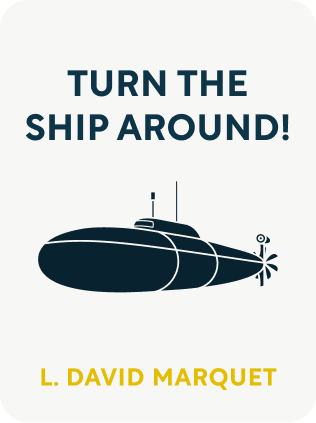

This article is an excerpt from the Shortform book guide to "Turn the Ship Around" by L. David Marquet. Shortform has the world's best summaries and analyses of books you should be reading.
Like this article? Sign up for a free trial here .
Have you read Turn the Ship Around by David Marquet? What leadership lessons can be learned?
In Turn the Ship Around, David Marquet tells the story of how a captain turned the U.S. Navy’s worst-performing nuclear submarine crew into one of the best by replacing the Navy’s traditional “leader-follower” (or command-and-control) structure with a “leader-leader” model that gave crew members control over their work. Its lessons are applicable to any organization—business, nonprofit, or government.
Read more to learn the lessons of Turn the Ship Around by David Marquet.
Turn the Ship Around by David Marquet
Turn the Ship Around! is the story of how Marquet replaced the Navy’s traditional “leader-follower” or command-and-control structure with a “leader-leader” organizational model. He transformed the demoralized crew into an empowered, motivated fighting force in just a year. They learned to think and act proactively, determining what needed to be done and the best way to do it, rather than waiting for direction.
In short, the “leader-leader” model allows staff to take responsibility for problems and solutions rather than waiting to be told what to do. As a result, team members see themselves as leaders instead of followers. Any organization can use Marquet’s principles for developing leaders at all levels to create a passionate, high-performing workforce.
The Leader-Follower Model
The traditional leader-follower model practiced in the U.S. Navy and most companies and organizations assumes there are two types of people: leaders who make decisions and followers who implement them.
This has been the basis of our thinking about leadership for hundreds of years because it has worked. It’s responsible for successes ranging from the construction of the pyramids in ancient Egypt to the factories of the Industrial Revolution.
In Turn the Ship Around, David Marquet points out that the leader-follower structure was designed to coordinate physical labor for various purposes, whether building pyramids and roads, or mining coal. In contrast, many of today’s employees are knowledge workers who work independently to develop and apply information. The leader-follower model doesn’t manage cognitive work effectively.
People who are treated as followers become passive. With scant decision-making ability, they have little motivation to contribute their ingenuity and energy.
The Leader-Leader Model
The leader-leader structure is based on a different assumption about people: everyone can be a leader, and an organization is most effective when everyone thinks and acts like a leader.
The leader-leader model treats employees as valued assets, which increases individual motivation and organizational success. Also, the improvements that come with the leader-leader model are lasting because they’re not dependent on one leader’s skill or personality. Leaders develop throughout the organization.
A Leadership Revolution
With little room for error, a nuclear submarine is an unlikely setting for trying out a new leadership model. But to turn around the beleaguered Santa Fe, Marquet felt he had no other option.
In Turn the Ship Around David Marquet explained that, when he took over as commander, he had six months to get the submarine ready for deployment. Santa Fe was to join a battle group for a torpedo exercise in the Arabian Gulf intended to demonstrate combat effectiveness. Marquet needed to radically change the way officers and crew operated.
Marquet’s goal was to create a leader-leader structure by pushing control—the authority to decide what to do and how—downward to the officers and crew. He started in the middle of the operation with the 12 chiefs, the senior enlisted personnel equivalent to middle managers, who supervised the crew members responsible for day-to-day maintenance and operation of the submarine.
Although there’s a Navy axiom that “the chiefs run the Navy,” they lacked true authority. By instituting a “Chiefs in Charge” program, Marquet made the chiefs accountable for the performance of their divisions and crew members. The chiefs’ new authority generated excitement and strengthened the connection between the chiefs and the sailors. Both the chiefs and crew became more engaged in their work.
‘Mechanisms’ for Success
Over time, Marquet and his officers came up with 20 “mechanisms” (Navy terminology for methods practices) to transform Santa Fe from a leader-follower to a leader-leader organization. The mechanisms focused on three key areas:
- Control: Decentralize decision-making to increase the crew’s initiative and motivation.
- Competence: Increase the crew’s technical competence and knowledge so they could make good decisions.
- Clarity: Ensure crew members are clear on the organization’s goals so their decisions align with what Santa Fe needed to accomplish.
Mechanisms for Decentralizing Control
The typical leader-follower structure is designed to push information up the chain of command to the people who make the decisions. In contrast, Marquet pushed control, or decision-making authority, down to where the information originated.
Besides pushing authority downward to the chiefs, here are the other mechanisms or methods Marquet used to spread control throughout the organization:
- Identify practices and procedures embedded in the organization—the “genetic code”—that dictate control and rewrite them.
- Get people to act differently and they’ll begin thinking differently (starting with the “three-name rule.”).
- Have supervisors do brief check-ins to ensure crew members are on the right track so time isn’t wasted.
- Have everyone start conversations with the phrase “I intend to…” instead of asking for permission to do something.
- As supervisors, resist the impulse to jump in with solutions when problems occur. Instead, let crew members decide what to do.
- Eliminate top-down systems for monitoring work. Instead, let crew members take ownership of the work and report their progress.
- Get people to “think out loud” about what they intend to do to clarify the rationale for decisions.
- Welcome inspectors as experts who can help the organization improve.
Of these practices, two stood out as having the greatest impact:
The ‘Three-Name Rule’
Marquet instituted a behavior change for the entire crew that led to changed thinking and morale: the “three-name rule.” This required that when any crew member saw a visitor, he would greet the person using three names: the visitor’s name, his name, and the ship’s name. It would go like this: “Good morning Commodore Kenny, my name is Petty Officer Smith. Welcome aboard Santa Fe.”
Crew members often felt at the mercy of outside factors rather than taking responsibility for making things happen. Practicing the three-name rule helped to break that cycle. By taking the initiative to greet visitors, each sailor was being proactive.
‘I Intend to…’
Marquet also instituted another language change that created a proactive mindset. In the old top-down system, officers and crew asked permission to do things, using “follower” phrases such as: “I’d like to,” or “What should I do about.” Instead, Marquet required everyone to state their intentions rather than ask permission. They would announce, “I intend to…” spelling out what they wanted to do, and Marquet or another officer would respond, “Very well.” Then they‘d proceed with their plans.
In this way, officers and crew took ownership of a situation or problem, decided what to do, and shared their intended actions.
Mechanisms for Increasing Competence
In Turn the Ship Around David Marquet argues that decentralizing control under a leader-leader system works only when the people receiving increased control have the technical competence or knowledge to make decisions. Marquet and his officers used the following mechanisms to strengthen the crew’s technical competence:
- Take “deliberate action”: Officers and crew pause before acting and state their intentions to prevent acting without thinking.
- Learn constantly: Officers and crew approached every activity as a chance to learn and improve.
- Demonstrate readiness: Instead of listening to a briefing or review of instructions, crew members demonstrate they’re prepared to proceed.
- Repeat the message of change until it fully sinks in. Old habits die hard.
- Specify goals, but let crew members decide the best methods for reaching them.
The mechanisms with the greatest impact on increasing the crew’s competence were: taking deliberate action and demonstrating readiness.
Take ‘Deliberate Action’
This initiative grew out of an error committed by a petty officer, who had acted automatically without thinking and violated a critical safety rule while connecting electrical cables to the submarine when it reached port.
To prevent this from happening in the future, they came up with a procedure aimed at getting people to act thoughtfully and deliberately, called “take deliberate action.” It meant that before taking any operational action, a crew member would pause, verbally state what he intended to do, and gesture toward the controls. The purpose was to engage the operator’s mind and eliminate acting automatically. In turn, this reduced mistakes.
Demonstrate Readiness
Briefings, or the practice of reading procedures out loud before an activity, were a common feature in the Navy. However, they were passive—everyone listened to the instructions; they had no responsibility to prepare in advance, and it was easy to assent without engaging mentally.
Marquet replaced briefings with certifications, in which participants demonstrated their readiness and were “certified” to proceed with a task. During certification, a team leader asked the members questions, then decided whether the team was ready. The certification process required people to actively prepare for their duties and increased everyone’s intellectual involvement in operations.
Mechanisms for Creating Clarity on Goals
In Turn the Ship Around David Marquet asserts that, along with competence, a leader-leader model that decentralizes control also requires clarity. Everyone needs to understand the organization’s goals so that the decisions they make align with what the organization is trying to accomplish. If the purpose isn’t clear, the criteria on which decisions are made may be off base, leading to bad decisions.
Here are the mechanisms Santa Fe adopted to ensure clarity:
- Focus on achieving excellent results, not on rotely following procedures in order to avoid errors.
- Take care of your team. Supervisors should build trust and motivation by putting the team’s interests first.
- Be inspired by your organization’s legacy. Create a sense of mission by connecting present efforts with past accomplishments.
- Create guiding principles to aid decision-making.
- Immediately recognize excellent performance.
- Begin with the end in mind: Set long-term goals.
- Encourage questions, not blind obedience.
The most important was focusing on achieving excellence.
Focus on Excellence
The Navy’s submarine force was obsessed with reporting, tracking, and analyzing errors, which created a strong incentive to focus exclusively on avoiding them. When Marquet first took command of Santa Fe, the crew focused on following myriad procedures intended to minimize errors.
While this might have prevented some problems, it was paralyzing and left no room for achieving excellence, which Marquet defined as “exceptional operational effectiveness.” While understanding and minimizing mistakes is valuable, it should be primarily a side benefit of excellence.
Officers helped crew members focus on excellence by creating a set of guiding principles for decision-making, and also by rewarding excellence. However, focusing on procedure to avoid errors proved to be an ingrained habit that resurfaced regularly until the crew developed greater competence and clarity about what they needed to accomplish.
Long-Term Success
Ultimately, Santa Fe’s achievements and innovations under Marquet’s leadership lasted long after his departure and spread throughout the submarine force.
Santa Fe produced leaders in disproportionate numbers compared to other submarines. Twelve years after Marquet took command of Santa Fe, Commander Dave Adams, former weapons officers under him, took charge. Two executive officers were selected to command submarines. Three department heads were promoted to executive officer and then to commanders of their own submarines. Many enlisted men were promoted as well.
In terms of operational performance, Santa Fe won the award for best chiefs’ quarters for seven years in a row and the Battle “E” award for most combat-effective submarine three times in 10 years. Deliberate action was adopted across the submarine force. Two other Santa Fe mechanisms—the “I intend to ..” procedure and certification—were picked up by others.
The leader-leader model is the only one that can produce top performance and long-term excellence. If the model can turn the Navy’s worst-performing submarine into its best, it can work in any organization.
In Turn the Ship Around David Marquet shares lessons are applicable to any organization—business, nonprofit, or government.

———End of Preview———
Like what you just read? Read the rest of the world's best book summary and analysis of L. David Marquet's "Turn the Ship Around" at Shortform .
Here's what you'll find in our full Turn the Ship Around summary :
- How a captain turned the U.S. Navy’s worst-performing nuclear submarine crew into one of the best
- The principles for developing leaders at all levels to create a passionate, high-performing workforce
- Why the "leader-leader" model works better than the "leader-follower" model






